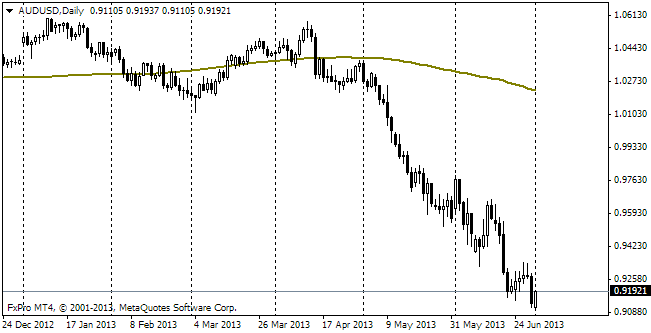EUR/usd
EUR keeps waging an attack as if it made up for the unimpressive beginning of the year. Then the dollar was expected to show almost immediate growth, believing that QE tapering was a good reason for the currency's appreciation. However, as seen, this reason is posed by the prospect of the rate increase. It's of interest that market participants often ran ahead of time then, expecting earlier toughening of the policy, though already in a few months there was nothing else to do but suppose further incentives. Now the situation seems to have changed radically. According to the Fed's research, the members of the fomc have more hawkish views on the monetary policy than the market participants. It seems that traders and analysts rely too much on history rather than facts. It is not yet clear who of them are right, but already now growth of the dollar on such news is a true thing. eurusd hit the 14-month low and dropped below 1.29. This week can become the ninth in the row of the euro's drops. Advocates of technical analysis, always considering support and resistance levels, appear to see the nearest important support only at 1.2750, which is close to the last year's lows. If this level doesn't become a reliable support for the pair, its decline will quickly develop further to 1.20. The market is hurrying to build a more hawkish sentiment of the Fed in the rates and the euro-bulls simply has nothing to go by and start correction. It looks as if to look for a moment to sell the dollar is as safe as to catch falling knives.
GBP/USD
GBP's feeble attempts to recoup its losses yesterday were a failure. It was a big discovery for investors to learn about a large share of Scots looking forward to independence. Now investment banks, even if they expect that Scotland will not secede from the UK, don't hurry to stake on that. Even the industrial production data, scheduled for release today, won't have much influence if above expectations (0.2 -0.3% m/m) and if they fall short of the expectations, it may spur outflow from the British currency. The referendum can become that very black swan – a rare event with grave and long-term consequences.

USD/JPY
The pair went beyond 106, continuing its confident ascent. Such high rates were last seen only in 2008. But even at these levels there is a daunting feeling that it is not the end of it. The BOJ has no reason to restrain incentives as the trade balance remains deficit. Metal and energy prices are falling, which can do good to the country, actively importing these commodities. In regard to this, it is expected that the yen will stop somewhere around 110, though 120 as well looks as a good target for the end of the next year.

AUD/USD
The aussie has dropped to the lower bound of the trading range since the beginning of August, being at 0.9260. But for all that the pair has the potential to fall down to 0.9200 and further to 0.9000. News draw a picture of cautiousness about purchasing new homes and certain correction of the Business Optimism Index. But investors are quite optimistic about the housing market, boosting lending in this sector at a neck-breaking pace (the highest for a bit more than a year).
